bonnet FIAT LINEA 2008 1.G Owners Manual
[x] Cancel search | Manufacturer: FIAT, Model Year: 2008, Model line: LINEA, Model: FIAT LINEA 2008 1.GPages: 234, PDF Size: 3.41 MB
Page 5 of 234
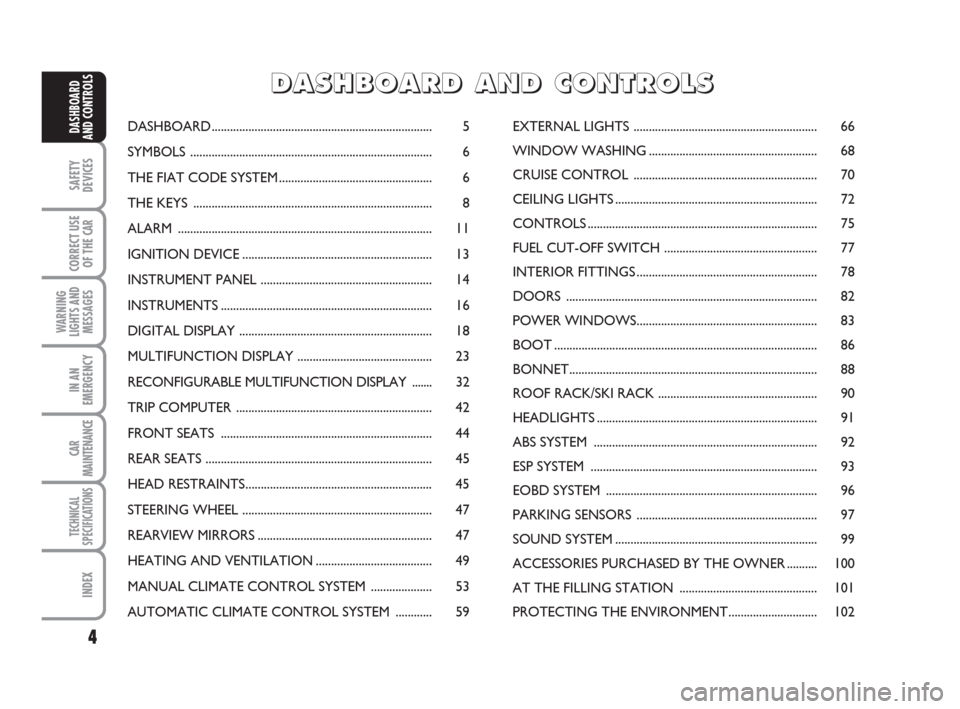
4
SAFETY
DEVICES
CORRECT USE
OF THE
CAR
WARNING
LIGHTS AND
MESSAGES
IN AN
EMERGENCY
CAR
MAINTENANCE
TECHNICAL
SPECIFICATIONS
INDEX
DASHBOARD
AND CONTROLSDASHBOARD........................................................................ 5
SYMBOLS ............................................................................... 6
THE FIAT CODE SYSTEM.................................................. 6
THE KEYS .............................................................................. 8
ALARM ................................................................................... 11
IGNITION DEVICE.............................................................. 13
INSTRUMENT PANEL ........................................................ 14
INSTRUMENTS..................................................................... 16
DIGITAL DISPLAY ............................................................... 18
MULTIFUNCTION DISPLAY ............................................ 23
RECONFIGURABLE MULTIFUNCTION DISPLAY ....... 32
TRIP COMPUTER ................................................................ 42
FRONT SEATS ..................................................................... 44
REAR SEATS .......................................................................... 45
HEAD RESTRAINTS............................................................. 45
STEERING WHEEL .............................................................. 47
REARVIEW MIRRORS......................................................... 47
HEATING AND VENTILATION...................................... 49
MANUAL CLIMATE CONTROL SYSTEM .................... 53
AUTOMATIC CLIMATE CONTROL SYSTEM ............ 59EXTERNAL LIGHTS ............................................................ 66
WINDOW WASHING....................................................... 68
CRUISE CONTROL ............................................................ 70
CEILING LIGHTS.................................................................. 72
CONTROLS........................................................................... 75
FUEL CUT-OFF SWITCH .................................................. 77
INTERIOR FITTINGS........................................................... 78
DOORS .................................................................................. 82
POWER WINDOWS........................................................... 83
BOOT ...................................................................................... 86
BONNET................................................................................. 88
ROOF RACK/SKI RACK .................................................... 90
HEADLIGHTS........................................................................ 91
ABS SYSTEM ......................................................................... 92
ESP SYSTEM .......................................................................... 93
EOBD SYSTEM ..................................................................... 96
PARKING SENSORS ........................................................... 97
SOUND SYSTEM.................................................................. 99
ACCESSORIES PURCHASED BY THE OWNER .......... 100
AT THE FILLING STATION ............................................. 101
PROTECTING THE ENVIRONMENT............................. 102
DD D
A A
S S
H H
B B
O O
A A
R R
D D
A A
N N
D D
C C
O O
N N
T T
R R
O O
L L
S S
001-031 LINEA 1ed GB 4-09-2008 14:55 Pagina 4
Page 7 of 234
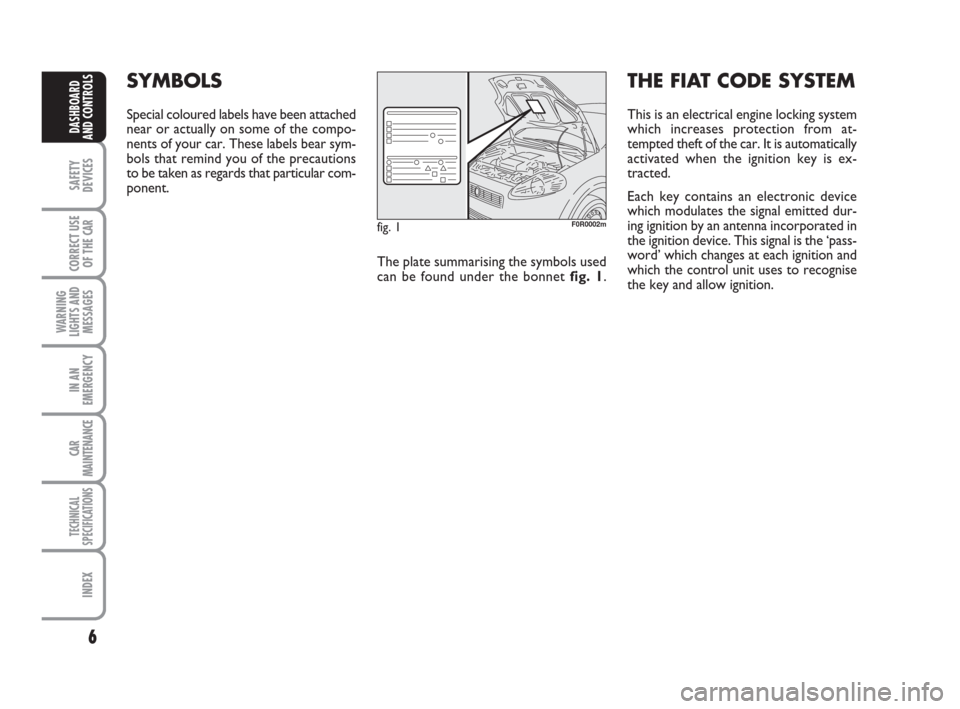
6
SAFETY
DEVICES
CORRECT USE
OF THE
CAR
WARNING
LIGHTS AND
MESSAGES
IN AN
EMERGENCY
CAR
MAINTENANCE
TECHNICAL
SPECIFICATIONS
INDEX
DASHBOARD
AND CONTROLS
SYMBOLS
Special coloured labels have been attached
near or actually on some of the compo-
nents of your car. These labels bear sym-
bols that remind you of the precautions
to be taken as regards that particular com-
ponent.
The plate summarising the symbols used
can be found under the bonnet fig. 1.
THE FIAT CODE SYSTEM
This is an electrical engine locking system
which increases protection from at-
tempted theft of the car. It is automatically
activated when the ignition key is ex-
tracted.
Each key contains an electronic device
which modulates the signal emitted dur-
ing ignition by an antenna incorporated in
the ignition device. This signal is the ‘pass-
word’ which changes at each ignition and
which the control unit uses to recognise
the key and allow ignition.
fig. 1F0R0002m
001-031 LINEA 1ed GB 4-09-2008 14:55 Pagina 6
Page 89 of 234
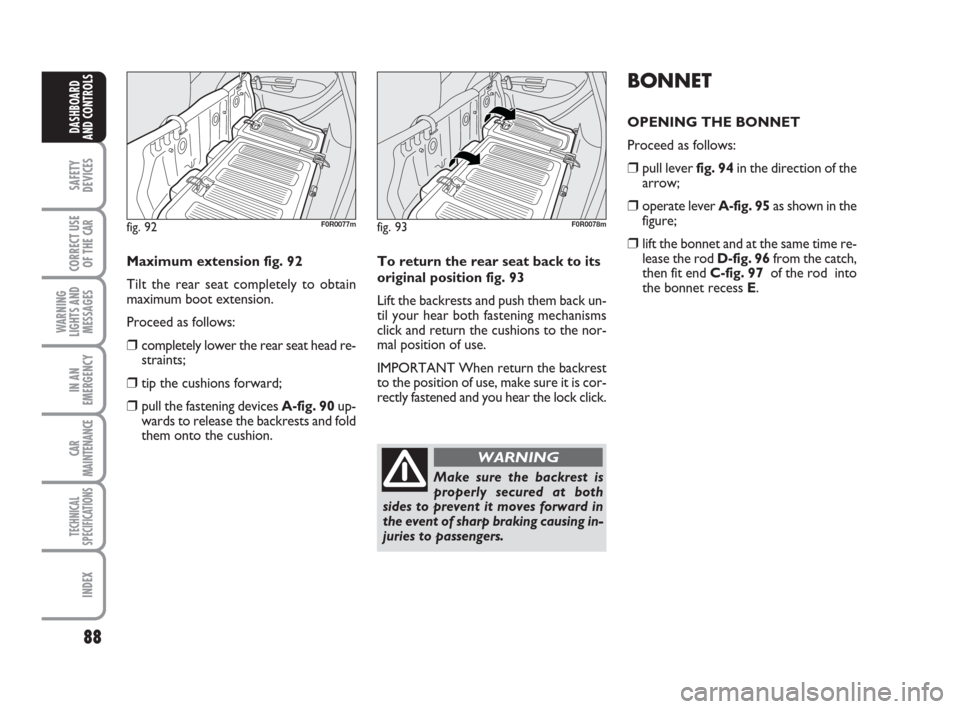
88
SAFETY
DEVICES
CORRECT USE
OF THE
CAR
WARNING
LIGHTS AND
MESSAGES
IN AN
EMERGENCY
CAR
MAINTENANCE
TECHNICAL
SPECIFICATIONS
INDEX
DASHBOARD
AND CONTROLS
fig. 93F0R0078m
To return the rear seat back to its
original position fig. 93
Lift the backrests and push them back un-
til your hear both fastening mechanisms
click and return the cushions to the nor-
mal position of use.
IMPORTANT When return the backrest
to the position of use, make sure it is cor-
rectly fastened and you hear the lock click. Maximum extension fig. 92
Tilt the rear seat completely to obtain
maximum boot extension.
Proceed as follows:
❒completely lower the rear seat head re-
straints;
❒tip the cushions forward;
❒pull the fastening devices A-fig. 90up-
wards to release the backrests and fold
them onto the cushion.
fig. 92F0R0077m
Make sure the backrest is
properly secured at both
sides to prevent it moves forward in
the event of sharp braking causing in-
juries to passengers.
WARNING
BONNET
OPENING THE BONNET
Proceed as follows:
❒pull lever fig. 94in the direction of the
arrow;
❒operate lever A-fig. 95as shown in the
figure;
❒lift the bonnet and at the same time re-
lease the rod D-fig. 96from the catch,
then fit end C-fig. 97 of the rod into
the bonnet recess E.
044-090 LINEA 1ed GB 3-09-2008 17:29 Pagina 88
Page 90 of 234
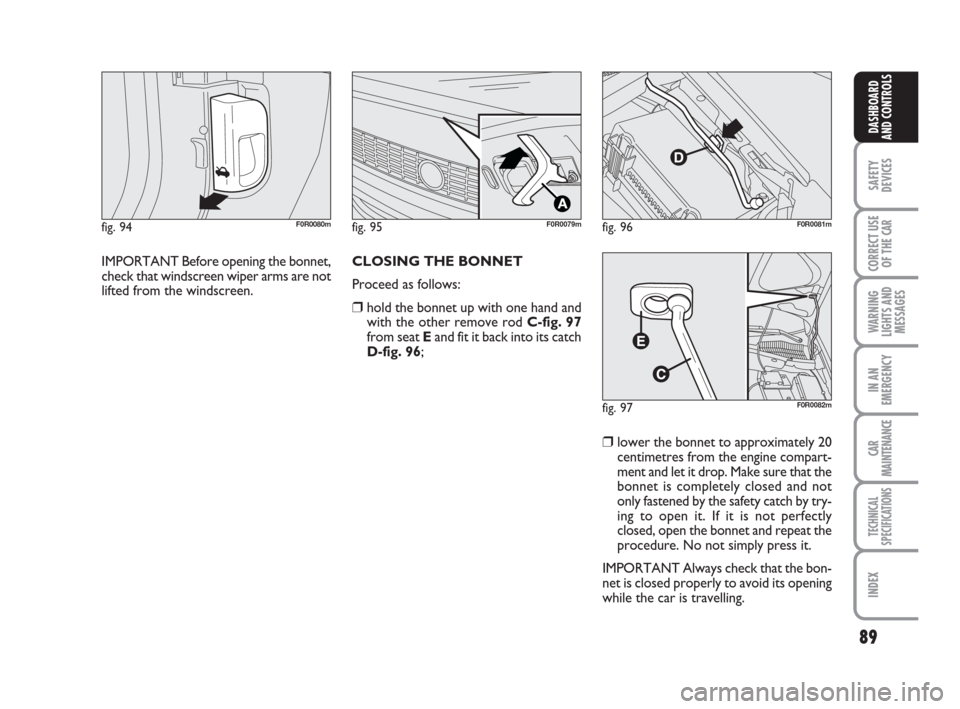
89
SAFETY
DEVICES
CORRECT USE
OF THE
CAR
WARNING
LIGHTS AND
MESSAGES
IN AN
EMERGENCY
CAR
MAINTENANCE
TECHNICAL
SPECIFICATIONS
INDEX
DASHBOARD
AND CONTROLS
IMPORTANT Before opening the bonnet,
check that windscreen wiper arms are not
lifted from the windscreen.CLOSING THE BONNET
Proceed as follows:
❒hold the bonnet up with one hand and
with the other remove rod C-fig. 97
from seat Eand fit it back into its catch
D-fig. 96;
❒lower the bonnet to approximately 20
centimetres from the engine compart-
ment and let it drop. Make sure that the
bonnet is completely closed and not
only fastened by the safety catch by try-
ing to open it. If it is not perfectly
closed, open the bonnet and repeat the
procedure. No not simply press it.
IMPORTANT Always check that the bon-
net is closed properly to avoid its opening
while the car is travelling.
fig. 94F0R0080mfig. 95F0R0079m
fig. 97F0R0082m
fig. 96F0R0081m
044-090 LINEA 1ed GB 3-09-2008 17:29 Pagina 89
Page 91 of 234
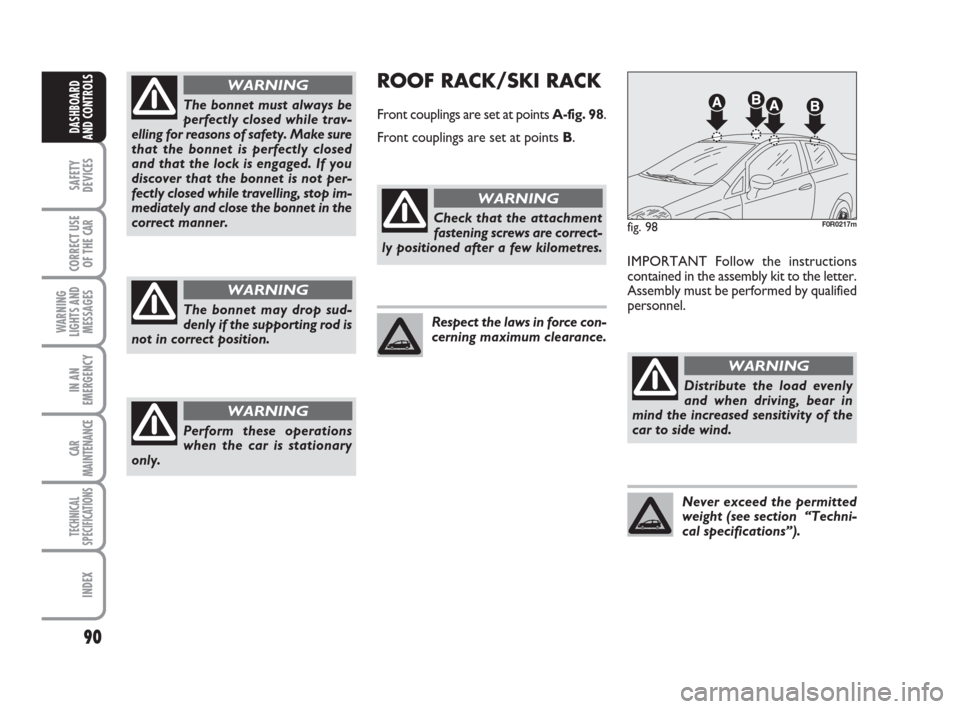
90
SAFETY
DEVICES
CORRECT USE
OF THE
CAR
WARNING
LIGHTS AND
MESSAGES
IN AN
EMERGENCY
CAR
MAINTENANCE
TECHNICAL
SPECIFICATIONS
INDEX
DASHBOARD
AND CONTROLS
The bonnet must always be
perfectly closed while trav-
elling for reasons of safety. Make sure
that the bonnet is perfectly closed
and that the lock is engaged. If you
discover that the bonnet is not per-
fectly closed while travelling, stop im-
mediately and close the bonnet in the
correct manner.
WARNING
The bonnet may drop sud-
denly if the supporting rod is
not in correct position.
WARNING
Perform these operations
when the car is stationary
only.
WARNING
ROOF RACK/SKI RACK
Front couplings are set at points A-fig. 98.
Front couplings are set at points B.
IMPORTANT Follow the instructions
contained in the assembly kit to the letter.
Assembly must be performed by qualified
personnel.
fig. 98F0R0217mCheck that the attachment
fastening screws are correct-
ly positioned after a few kilometres.
WARNING
Respect the laws in force con-
cerning maximum clearance.
Distribute the load evenly
and when driving, bear in
mind the increased sensitivity of the
car to side wind.
WARNING
Never exceed the permitted
weight (see section “Techni-
cal specifications”).
044-090 LINEA 1ed GB 3-09-2008 17:29 Pagina 90
Page 180 of 234
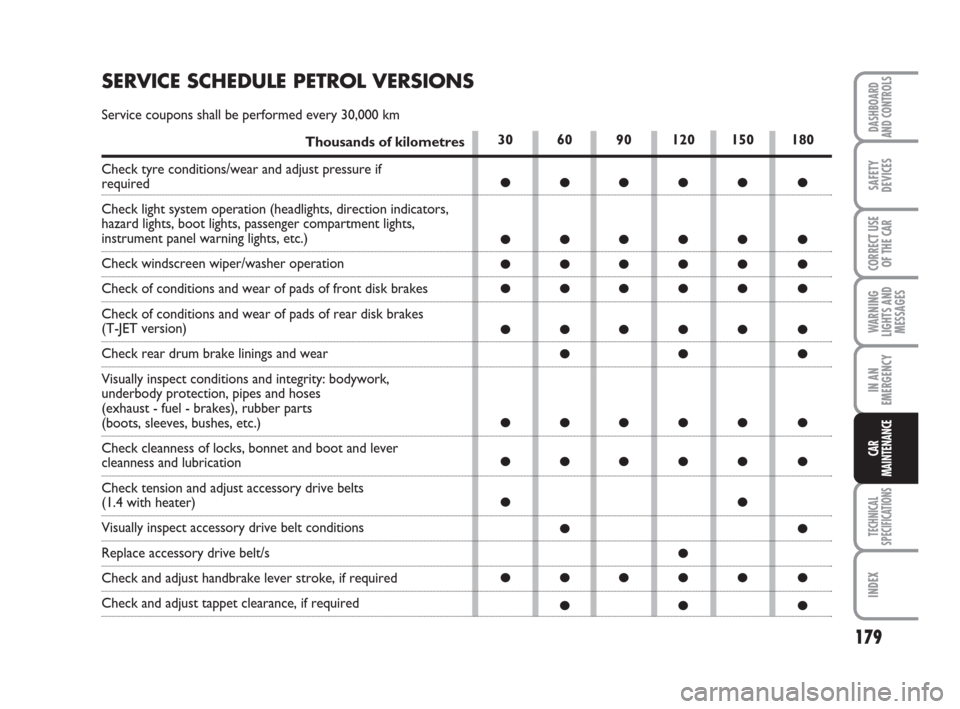
179
WARNING
LIGHTS AND
MESSAGES
TECHNICAL
SPECIFICATIONS
INDEX
DASHBOARD
AND CONTROLS
SAFETY
DEVICES
CORRECT USE
OF THE CAR
IN AN
EMERGENCY
CAR
MAINTENANCE
30 60 90 120 150 180
●●●●● ●
●●●●● ●
●●●●● ●
●●●●● ●
●●●●● ●
●● ●
●●●●● ●
●●●●● ●
●●
●●
●
●●●●● ●
●● ●
SERVICE SCHEDULE PETROL VERSIONS
Service coupons shall be performed every 30,000 km
Thousands of kilometres
Check tyre conditions/wear and adjust pressure if
required
Check light system operation (headlights, direction indicators,
hazard lights, boot lights, passenger compartment lights,
instrument panel warning lights, etc.)
Check windscreen wiper/washer operation
Check of conditions and wear of pads of front disk brakes
Check of conditions and wear of pads of rear disk brakes
(T-JET version)
Check rear drum brake linings and wear
Visually inspect conditions and integrity: bodywork,
underbody protection, pipes and hoses
(exhaust - fuel - brakes), rubber parts
(boots, sleeves, bushes, etc.)
Check cleanness of locks, bonnet and boot and lever
cleanness and lubrication
Check tension and adjust accessory drive belts
(1.4 with heater)
Visually inspect accessory drive belt conditions
Replace accessory drive belt/s
Check and adjust handbrake lever stroke, if required
Check and adjust tappet clearance, if required
177-200 LINEA 1ed GB 3-09-2008 17:31 Pagina 179
Page 182 of 234
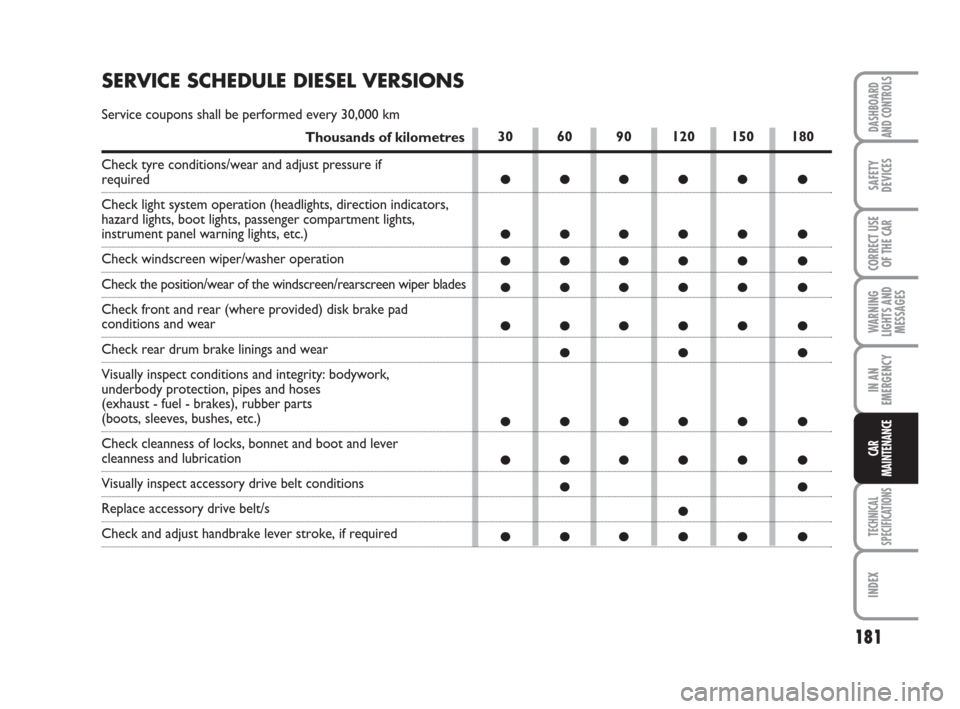
181
WARNING
LIGHTS AND
MESSAGES
TECHNICAL
SPECIFICATIONS
INDEX
DASHBOARD
AND CONTROLS
SAFETY
DEVICES
CORRECT USE
OF THE CAR
IN AN
EMERGENCY
CAR
MAINTENANCE
30 60 90 120 150 180
●●●●● ●
●●●●● ●
●●●●● ●
●●●●● ●
●●●●● ●
●● ●
●●●●● ●
●●●●● ●
●●
●
●●●●● ●
SERVICE SCHEDULE DIESEL VERSIONS
Service coupons shall be performed every 30,000 km
Thousands of kilometres
Check tyre conditions/wear and adjust pressure if
required
Check light system operation (headlights, direction indicators,
hazard lights, boot lights, passenger compartment lights,
instrument panel warning lights, etc.)
Check windscreen wiper/washer operation
Check the position/wear of the windscreen/rearscreen wiper blades
Check front and rear (where provided) disk brake pad
conditions and wear
Check rear drum brake linings and wear
Visually inspect conditions and integrity: bodywork,
underbody protection, pipes and hoses
(exhaust - fuel - brakes), rubber parts
(boots, sleeves, bushes, etc.)
Check cleanness of locks, bonnet and boot and lever
cleanness and lubrication
Visually inspect accessory drive belt conditions
Replace accessory drive belt/s
Check and adjust handbrake lever stroke, if required
177-200 LINEA 1ed GB 3-09-2008 17:31 Pagina 181
Page 184 of 234
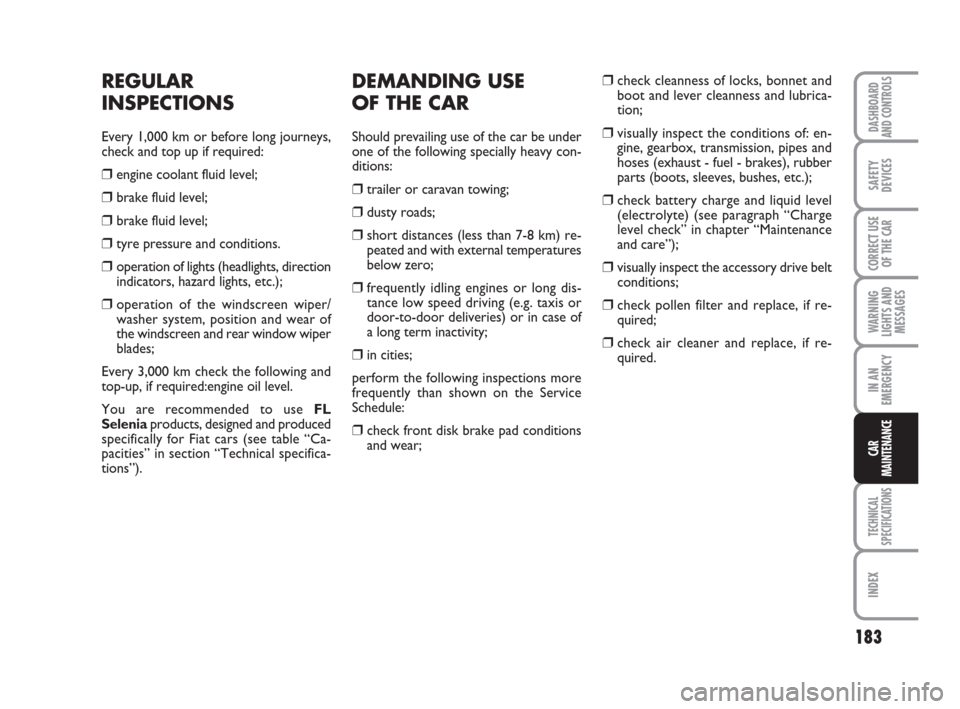
183
WARNING
LIGHTS AND
MESSAGES
TECHNICAL
SPECIFICATIONS
INDEX
DASHBOARD
AND CONTROLS
SAFETY
DEVICES
CORRECT USE
OF THE CAR
IN AN
EMERGENCY
CAR
MAINTENANCE
DEMANDING USE
OF THE CAR
Should prevailing use of the car be under
one of the following specially heavy con-
ditions:
❒trailer or caravan towing;
❒dusty roads;
❒short distances (less than 7-8 km) re-
peated and with external temperatures
below zero;
❒frequently idling engines or long dis-
tance low speed driving (e.g. taxis or
door-to-door deliveries) or in case of
a long term inactivity;
❒in cities;
perform the following inspections more
frequently than shown on the Service
Schedule:
❒check front disk brake pad conditions
and wear;
❒check cleanness of locks, bonnet and
boot and lever cleanness and lubrica-
tion;
❒visually inspect the conditions of: en-
gine, gearbox, transmission, pipes and
hoses (exhaust - fuel - brakes), rubber
parts (boots, sleeves, bushes, etc.);
❒check battery charge and liquid level
(electrolyte) (see paragraph “Charge
level check” in chapter “Maintenance
and care”);
❒visually inspect the accessory drive belt
conditions;
❒check pollen filter and replace, if re-
quired;
❒check air cleaner and replace, if re-
quired.
REGULAR
INSPECTIONS
Every 1,000 km or before long journeys,
check and top up if required:
❒engine coolant fluid level;
❒brake fluid level;
❒brake fluid level;
❒tyre pressure and conditions.
❒operation of lights (headlights, direction
indicators, hazard lights, etc.);
❒operation of the windscreen wiper/
washer system, position and wear of
the windscreen and rear window wiper
blades;
Every 3,000 km check the following and
top-up, if required:engine oil level.
You are recommended to use FL
Seleniaproducts, designed and produced
specifically for Fiat cars (see table “Ca-
pacities” in section “Technical specifica-
tions”).
177-200 LINEA 1ed GB 3-09-2008 17:31 Pagina 183
Page 193 of 234
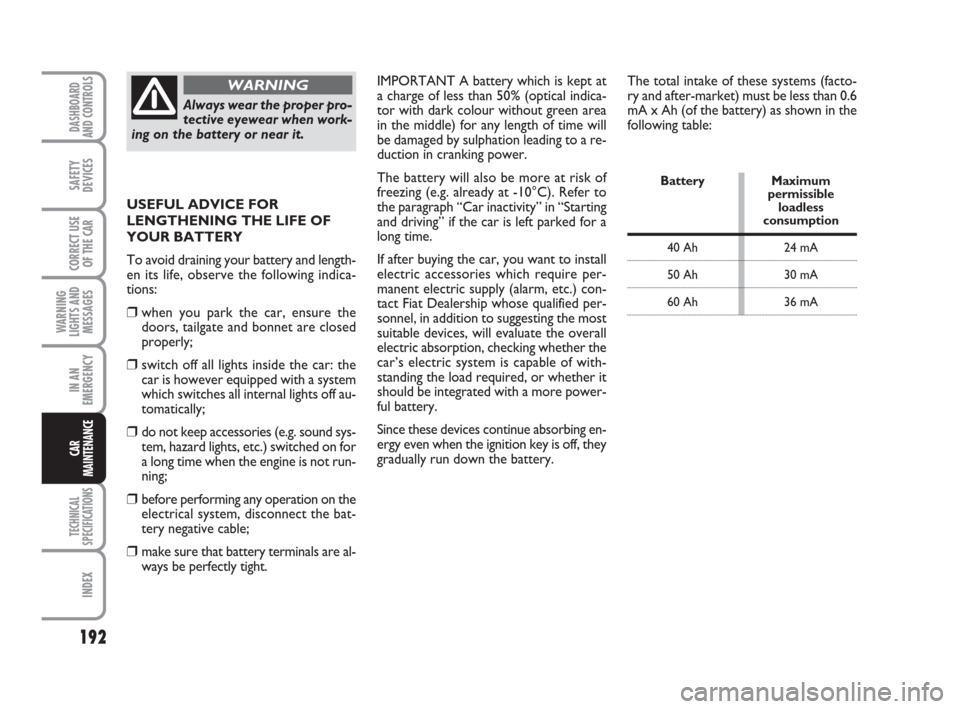
192
WARNING
LIGHTS AND
MESSAGES
TECHNICAL
SPECIFICATIONS
INDEX
DASHBOARD
AND CONTROLS
SAFETY
DEVICES
CORRECT USE
OF THE CAR
IN AN
EMERGENCY
CAR
MAINTENANCE
The total intake of these systems (facto-
ry and after-market) must be less than 0.6
mA x Ah (of the battery) as shown in the
following table:
Battery Maximum
permissible
loadless
consumption
40 Ah 24 mA
50 Ah 30 mA
60 Ah 36 mA
IMPORTANT A battery which is kept at
a charge of less than 50% (optical indica-
tor with dark colour without green area
in the middle) for any length of time will
be damaged by sulphation leading to a re-
duction in cranking power.
The battery will also be more at risk of
freezing (e.g. already at -10°C). Refer to
the paragraph “Car inactivity” in “Starting
and driving” if the car is left parked for a
long time.
If after buying the car, you want to install
electric accessories which require per-
manent electric supply (alarm, etc.) con-
tact Fiat Dealership whose qualified per-
sonnel, in addition to suggesting the most
suitable devices, will evaluate the overall
electric absorption, checking whether the
car’s electric system is capable of with-
standing the load required, or whether it
should be integrated with a more power-
ful battery.
Since these devices continue absorbing en-
ergy even when the ignition key is off, they
gradually run down the battery. USEFUL ADVICE FOR
LENGTHENING THE LIFE OF
YOUR BATTERY
To avoid draining your battery and length-
en its life, observe the following indica-
tions:
❒when you park the car, ensure the
doors, tailgate and bonnet are closed
properly;
❒switch off all lights inside the car: the
car is however equipped with a system
which switches all internal lights off au-
tomatically;
❒do not keep accessories (e.g. sound sys-
tem, hazard lights, etc.) switched on for
a long time when the engine is not run-
ning;
❒before performing any operation on the
electrical system, disconnect the bat-
tery negative cable;
❒make sure that battery terminals are al-
ways be perfectly tight.
Always wear the proper pro-
tective eyewear when work-
ing on the battery or near it.
WARNING
177-200 LINEA 1ed GB 3-09-2008 17:31 Pagina 192
Page 198 of 234
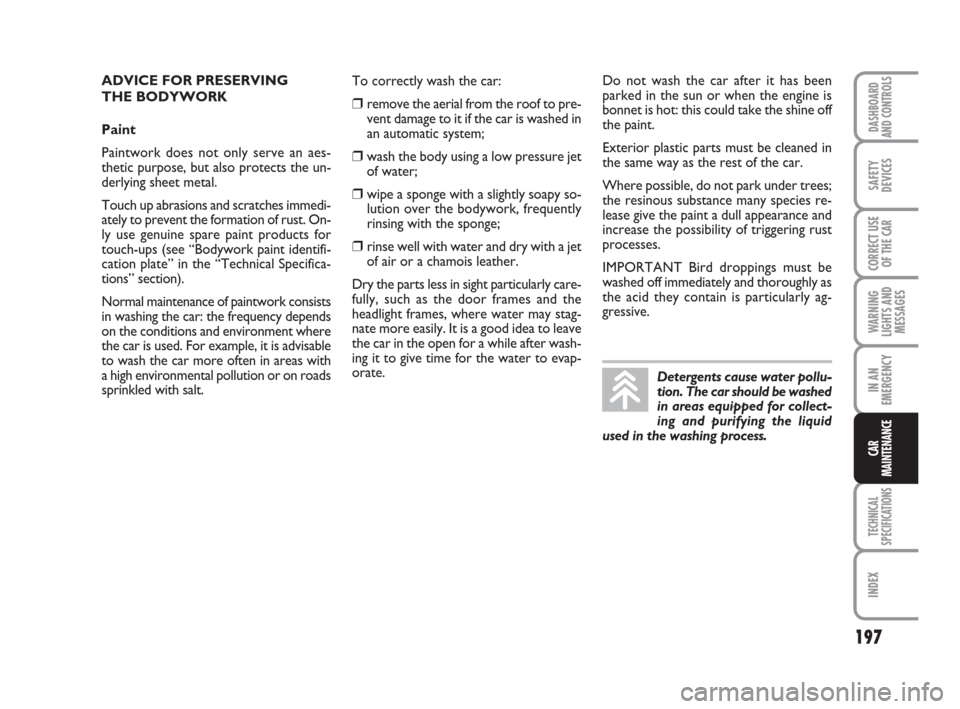
197
WARNING
LIGHTS AND
MESSAGES
TECHNICAL
SPECIFICATIONS
INDEX
DASHBOARD
AND CONTROLS
SAFETY
DEVICES
CORRECT USE
OF THE CAR
IN AN
EMERGENCY
CAR
MAINTENANCE
ADVICE FOR PRESERVING
THE BODYWORK
Paint
Paintwork does not only serve an aes-
thetic purpose, but also protects the un-
derlying sheet metal.
Touch up abrasions and scratches immedi-
ately to prevent the formation of rust. On-
ly use genuine spare paint products for
touch-ups (see “Bodywork paint identifi-
cation plate” in the “Technical Specifica-
tions” section).
Normal maintenance of paintwork consists
in washing the car: the frequency depends
on the conditions and environment where
the car is used. For example, it is advisable
to wash the car more often in areas with
a high environmental pollution or on roads
sprinkled with salt.To correctly wash the car:
❒remove the aerial from the roof to pre-
vent damage to it if the car is washed in
an automatic system;
❒wash the body using a low pressure jet
of water;
❒wipe a sponge with a slightly soapy so-
lution over the bodywork, frequently
rinsing with the sponge;
❒rinse well with water and dry with a jet
of air or a chamois leather.
Dry the parts less in sight particularly care-
fully, such as the door frames and the
headlight frames, where water may stag-
nate more easily. It is a good idea to leave
the car in the open for a while after wash-
ing it to give time for the water to evap-
orate.Do not wash the car after it has been
parked in the sun or when the engine is
bonnet is hot: this could take the shine off
the paint.
Exterior plastic parts must be cleaned in
the same way as the rest of the car.
Where possible, do not park under trees;
the resinous substance many species re-
lease give the paint a dull appearance and
increase the possibility of triggering rust
processes.
IMPORTANT Bird droppings must be
washed off immediately and thoroughly as
the acid they contain is particularly ag-
gressive.
Detergents cause water pollu-
tion. The car should be washed
in areas equipped for collect-
ing and purifying the liquid
used in the washing process.
177-200 LINEA 1ed GB 3-09-2008 17:31 Pagina 197